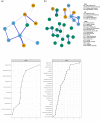Caregiving-related experiences associated with depression severity and its symptomatology among caregivers of individuals with a severe mental disorder: an online cross-sectional study
- PMID: 35771258
- PMCID: PMC9245882
- DOI: 10.1007/s00406-022-01451-3
Caregiving-related experiences associated with depression severity and its symptomatology among caregivers of individuals with a severe mental disorder: an online cross-sectional study
Abstract
Caring for a relative with a severe mental disorder puts family caregivers to a great risk of depression. While overall caregiving burden is a strong predictor of depression, the contribution of the various dimensions of burden to caregivers' depression as well as their relationships with depressive symptoms has received little attention. 384 family caregivers completed a cross-sectional online survey including the Center for Epidemiological Studies Depression (CES-D) scale, the Zarit Burden Interview (ZBI), and the Brief Experience of Caregiving Inventory (BECI), measuring caregiving burden and experience. We estimated the structure of the relationships between caregiving experiences (i.e., ZBI and BECI subscales) and CES-D symptoms using a network approach. Negative Emotion/Consequences, (lack of) Positive Personal Experience, and Stigma/Effects on Family were the most connected caregiving dimensions to depression. To untangle the role of the Negative Emotion/Consequences component (by far the most central node in estimated networks), a secondary analysis incorporating its composing items was estimated. Losing control over life, feeling strained around the relative and impaired self-perceived health emerged as central nodes. Interestingly, these caregiving-related dimensions or experiences were differentially connected to depressive symptoms. We discuss how these findings might help future research and inform tailored psychoeducational interventions for family caregivers of people with a severe mental disorder.
Keywords: Burden; Caregiver; Depression; Mental illness; Network analysis; Psychiatry.
© 2022. The Author(s).
Conflict of interest statement
The authors declare that they have no conflict of interest.
Figures



Similar articles
-
A study of the relationship between social support, caregiving experience and depressed mood of family caregivers of home-dwelling older adults with disability- - a cross-sectional study.BMC Public Health. 2025 Mar 17;25(1):1021. doi: 10.1186/s12889-025-22276-4. BMC Public Health. 2025. PMID: 40097955 Free PMC article.
-
Depressive symptoms in patients with heart failure negatively affect family caregiver outcomes and quality of life.Eur J Cardiovasc Nurs. 2016 Feb;15(1):30-8. doi: 10.1177/1474515114535329. Epub 2014 May 14. Eur J Cardiovasc Nurs. 2016. PMID: 24829295
-
Social support and depressive symptoms among family caregivers of older people with disabilities in four provinces of urban China: the mediating role of caregiver burden.BMC Geriatr. 2020 Jan 2;20(1):3. doi: 10.1186/s12877-019-1403-9. BMC Geriatr. 2020. PMID: 31898490 Free PMC article.
-
[Caregiver burden in relatives of persons with schizophrenia: an overview of measure instruments].Encephale. 2003 Mar-Apr;29(2):137-47. Encephale. 2003. PMID: 14567165 Review. French.
-
[Caregiving consequences in mental disorders--definitions and instruments of assessment].Psychiatr Pol. 2010 Jul-Aug;44(4):519-27. Psychiatr Pol. 2010. PMID: 20919503 Review. Polish.
Cited by
-
Challenges in Healthcare Management of Individuals with Special Needs in Malaysia: Perceptions of Caregivers.J Int Soc Prev Community Dent. 2023 Apr 28;13(2):148-156. doi: 10.4103/jispcd.JISPCD_234_22. eCollection 2023 Mar-Apr. J Int Soc Prev Community Dent. 2023. PMID: 37223444 Free PMC article.
-
Caregiving experiences of family caregivers of patients with schizophrenia in a community: a qualitative study in Beijing.BMJ Open. 2024 Apr 8;14(4):e081364. doi: 10.1136/bmjopen-2023-081364. BMJ Open. 2024. PMID: 38589261 Free PMC article.
References
-
- Schizophrenia Commission (2012) The Abandoned illness: A report by the Schizophrenia Commission
-
- Mittendorfer-Rutz E, Rahman S, Tanskanen A, et al. Burden for parents of patients with schizophrenia—a nationwide comparative study of parents of offspring with rheumatoid arthritis, multiple sclerosis, epilepsy, and healthy controls. Schizophr Bull. 2019;45:794–803. doi: 10.1093/schbul/sby130. - DOI - PMC - PubMed
-
- Gonçalves-Pereira M, González-Fraile E, Santos-Zorrozúa B, et al. Assessment of the consequences of caregiving in psychosis: a psychometric comparison of the Zarit Burden Interview (ZBI) and the Involvement Evaluation Questionnaire (IEQ) Health Qual Life Outcomes. 2017;15:63. doi: 10.1186/s12955-017-0626-8. - DOI - PMC - PubMed
MeSH terms
LinkOut - more resources
Full Text Sources
Medical

